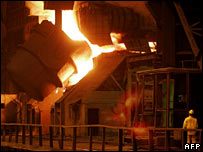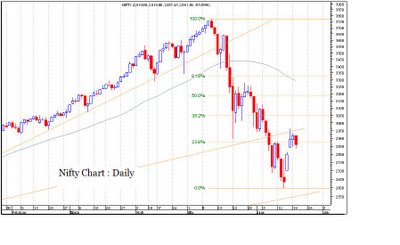Sensex is a basket of 30 constituent stocks representing a sample of large, liquid and representative companies. These 30 stocks are the most active and representative stocks selected from over 6,300 scrips that are listed on the BSE.
The total market capitalization of these 30 stocks accounts for more than 38 per cent of the aggregate market capitalization of all BSE stocks.
Most of the times, we also refer to Nifty along with Sensex. S&P CNX Nifty (referred as Nifty) is the index of the National Stock Exchange (NSE). The S&P CNX Nifty (Standard and Poor - an investment advisory company), since its inception, has attained great popularity among investors.
1 ) What are the objectives of Sensex?
Sensex is treated as the benchmark index of the Indian capital markets with wide acceptance globally among individual investors, institutional investors, foreign investors and fund managers. The main objectives of the index are to measure market movements and to be a benchmark for fund managers to compare their fund performance.
2 ) Who selects the 30 stocks?
They are selected by the index committee. This committee consists of individuals including academicians, mutual fund managers, finance journalists, independent governing board members and other participants in the financial markets.
3 ) How are the stocks selected in the Sensex?
The main criteria of the selection include the following:
(A)Market capitalization:
The scrip to be included should figure in the top 100 companies listed by market capitalization. Also the market capitalization of each company should be more than 0.5 per cent of the total market capitalization of the Index. (Market capitalization would be averaged
for last six months)
(B) Liquidity:
(i) Trading frequency: The scrip to be included should have been traded on each and every trading day for the last one year. Exceptions can be made for extreme reasons like scrip suspension etc.
(ii) Number of trades: The scrip should be among the top 150 companies listed by average number of trades per day for the last one year.
(iii) Value of shares traded: The scrip should be among the top 150 companies listed by average value of shares traded per day for the last one year.
(C) Continuity:
Whenever the composition of the index is changed, the continuity of historical series of index values is re-established by correlating the value of the revised index to the old index (index before revision). The back calculation over the last one-year period is carried out and correlation of the revised index to the old index should not be less than 0.98. This ensures that the historical continuity of the index is maintained.
(D) Industry representation:
Scrip selection would take into account a balanced representation of the listed companies in the universe of BSE. The index companies should be leaders in their industry group.
(E) Listed history:
The scrip should have a listing history of at least one year on BSE.
(F) Track record:
In the opinion of the index committee, the company should have an acceptable track record.
The index was initially calculated based on the "full market capitalization" methodology but was shifted to the free-float methodology with effect from September 1, 2003. The "free-float market capitalization" methodology of index construction is regarded as an industry best practice globally.
All major index providers like MSCI, FTSE, STOXX, S&P and Dow Jones use the free-float methodology.
As per the "free-float market capitalization" methodology, the level of index at any point of time reflects the Free-float market value of 30 component stocks relative to a base period.
The market capitalization of a company is determined by multiplying the price of its stock by the number of shares issued by the company. This market capitalization is further multiplied by the free-float factor to determine the free-float market capitalization.
The base period of Sensex is 1978-79 and the base value is 100 index points. This is often indicated by the notation 1978-79=100. The calculation of Sensex involves dividing the free-float market capitalization of 30 companies in the index by a number called the index divisor. The divisor is the only link to the original base period value of the Sensex. It keeps the index comparable over time and is the adjustment point for all index adjustments arising out of
Corporate actions, replacement of scrips etc.
During market hours, prices of the index scrips, at which latest trades are executed, are used by the trading system to calculate Sensex every 15 seconds and disseminated in real time.
4 ) What is Free-float?
Share holdings held by investors that would not, in the normal course come into the open market for trading are treated as 'controlling/ strategic holdings' and hence not included in free-float. In specific, the following categories of holding are generally excluded from the definition of free-float:
• Holdings by founders/directors/ acquirers which has control element
• Holdings by persons/ bodies with "controlling interest"
• Government holding as promoter/acquirer
• Holdings through the FDI Route
• Strategic stakes by private corporate bodies/ individuals
• Equity held by associate/group companies (cross-holdings)
• Equity held by employee welfare trusts
• Locked-in shares and shares which would not be sold in the open market in
normal course.
The remaining shareholders would fall under the free-float category.
5 ) How is the closing Sensex figure calculated?
The closing Sensex on any trading day is computed taking the weighted average of all the trades on Sensex constituents in the last 30 minutes of trading session. If a Sensex constituent has not traded in the last 30 minutes, the last traded price is taken for computation of the index closure. If a Sensex constituent has not traded at all in a day, then its last day's closing price is taken for computation of index closure. The use of index closure algorithm prevents any intentional manipulation of the closing index value.
6 ) How is the routine maintenance of Sensex carried out?
One of the important aspects of maintaining continuity with the past is to update the base year average. The base year value adjustment ensures that additional issue of capital and other corporate announcements like bonus etc. do not destroy the value of the index. The beauty of maintenance lies in the fact that adjustments for corporate actions in the Index should not per se affect the index values.
The index cell of the exchange does the day-to-day maintenance of the index within the broad index policy framework set by the index committee. The index cell takes special care to ensure that Sensex and all the other BSE indices maintain their benchmark properties by striking a delicate balance between high turnover in index scrips and its representative character.
The index committee of the exchange has experts from different field of finance related to the capital markets. They include academicians, fund-managers from leading mutual funds, finance - journalists, market participants, independent governing board members, and exchange administration.
7 ) How are adjustments for Bonus, Rights and newly issued capital carried out in Sensex?
The arithmetic calculation involved in calculating Sensex is simple, but problem arises when one of the component stocks pays a bonus or issues rights shares. If no adjustments were made, a discontinuity would arise between the current value of the index and its previous value. The index cell of the exchange periodically adjusts the base value to take care of such corporate announcements.
(A) Adjustments for rights issues:
When a company, included in the compilation of the index, issues right shares, the market capitalisation of that company is increased by the number of additional shares issued based on the theoretical (ex-right) price.
An offsetting or proportionate adjustment is then made to the base market capitalisation.
(B) Adjustments for bonus issue:
When a company, included in the compilation of the index, issues bonus shares, the market capitalisation of that company does not undergo any change. Therefore, there is no change in the base market capitalisation, only the 'number of shares' in the formula is updated.
(C) Other issues:
Base market capitalisation adjustment is required when new shares are issued by way of conversion of debentures, mergers, spin-offs etc. or when equity is reduced by way of buy-back of shares, corporate restructuring etc.
(D) Base market capitalisation adjustment:
The formula for adjusting the base market capitalisation is as follows:
New base market capitalisation = old base market capitalisation X (New market capitalisation/old market capitalisation)
For example, suppose a company issues right shares which increases the market capitalisation of the shares of that company by say, Rs.100 crores. The existing base market capitalisation (old base market capitalisation), say, is Rs.2,450 crores and the aggregate market capitalisation of all the shares included in the index before the right issue is made is, say Rs.4,781 crores.
The "new base market capitalisation” will then be: Rs.2, 501.24 crores = 2,450 X (4,781+100)/4,781
This figure of 2,501.24 will be used as the base market capitalisation for calculating the index number from then onwards till the next base change becomes necessary.
8 ) How are the Sensex constituents reviewed?
The index committee meets every quarter to review all BSE indices. However, every review meeting need not necessarily result in a change in the index constituents. In case of a revision in the index constituents, the announcement of the incoming and outgoing scrips is made six weeks in advance of the actual implementation of the revision of the index.



